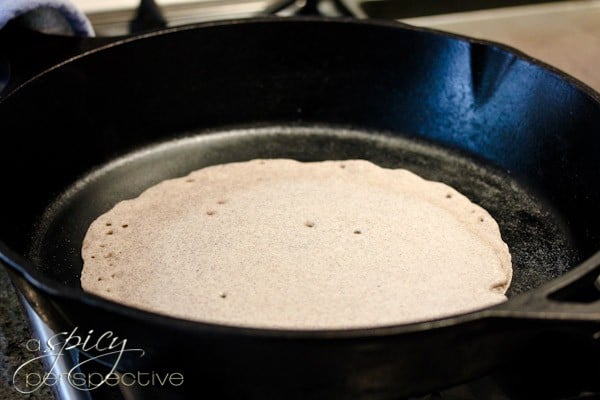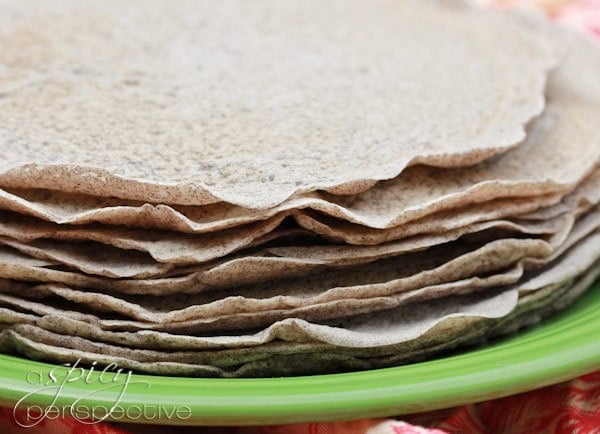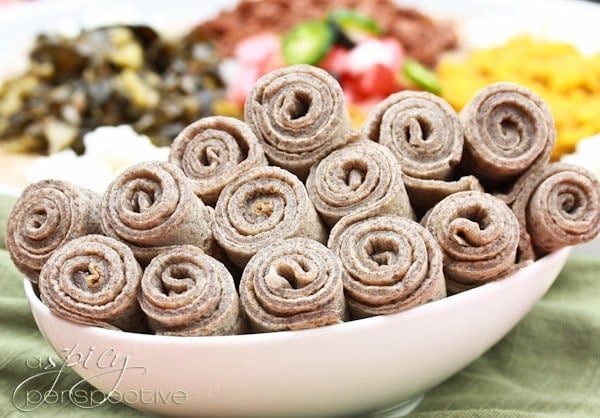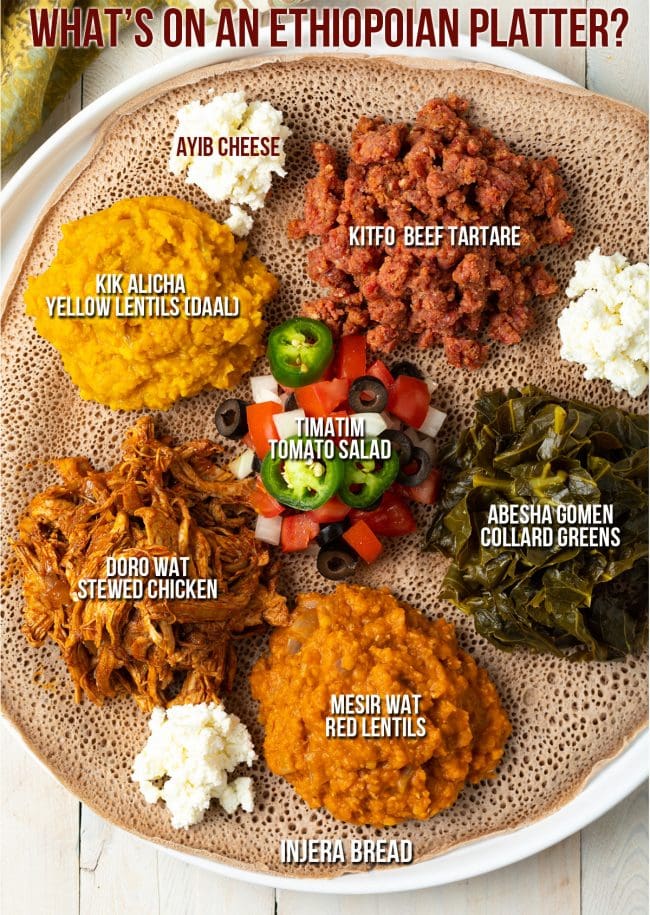Ethiopian Bread
This Ethiopian Bread recipe is a quick and easy take on the traditional Injera and features a sourdough crepe-like flatbread that you can make at home!


Sommer’s Recipe Notes
Several major American cities have large Ethiopian populations with amazing restaurants and markets throughout. Washington D.C., New York, Chicago, Atlanta, and Dallas are among the largest. And every time we visit family in Dallas, we always eat delicious Injera bread at our favorite Ethiopian restaurant.
Ethiopian Breaad, known as Injera, is a staple Ethiopian dish that you definitely need to learn how to make at home! This sourdough flatbread is always paired with other dishes to soak up the saucy meats, veggies and beans that it accompanies.
Why You’ll Love Ethiopian Bread
- Wonderful texture – This soft and spongy traditional Ethiopian bread is great for scooping up big chunks of stews.
- Diet-friendly – Injera is naturally dairy-free and egg-free!
- Make-ahead hero – Make big batches of this flatbread recipe and store it in the freezer for future use.
Our Easy Ethiopian Bread is not only quick and easy to make in any nonstick skillet, but it’s also tender, rollable, and undoubtedly sour… With absolutely no wait time.

Ingredients and Tips
- All-purpose flour – Use traditional flour to make the sourdough crepes soft and pliable.
- Buckwheat flour – For that pop of color and soft, spongy texture use buckwheat flour.
- Baking Soda – Baking soda will give light air bubbles.
- Club Soda – Club soda will also help to create the bubbly texture.
- Vinegar – Use a good quality vinegar to create the fermented sour taste.
Recipe Variations and Dietary Swaps
- Lemon juice – Swap vinegar with lemon juice for a similar flavor.
- Spices – Add cumin or coriander for an aromatic twist.
- Gluten-free – Use gluten-free all-purpose flour.
- Teff flour – To make a traditional Injera, swap both the all-purpose flour and buckwheat flour with teff flour Just keep in mind that teff flour is hard to find.

How To Make Ethiopian Bread
Injera at Ethiopian restaurants is made as large pizza-sized circular crepes. At home, you can make it in any good nonstick skillet you have available. Just mix the ingredients for the batter, cook it up and then roll the crepes into your final dish!
Find the full Ethiopian Bread recipe with detailed instructions and storage tips in the printable form at the bottom of the post!



Storage Notes
- Storing Leftovers – Store leftover Ethiopian bread in an airtight container and in the refrigerator for up to 3 days.
- Freezing Leftovers – Place cooked Injera stacked on top of one another between parchment paper. Wrap it tightly in plastic wrap and freeze for 2 months.
- Reheating Leftovers – I recommend warming these up in the oven.
Serving Suggestions
Ethiopian “Queen” Platters are a great idea for your adventurous dinner guest’s menu. There’s nothing like sitting around a large colorful platter of exotic dishes, scooping them up with your hands. Oh, the memories you will make!
Serve fresh-made Injera Bread with any of the below Ethiopian stews!
- Chicken Doro Wat (a chicken stew made in the slow cooker)
- Kitfo Ethiopian Beef Tartare or Tere Siga (minced raw meat)
- Mesir Wat Red Lentil Stew
- Ayib Cheese
- Yellow Peas like Daal
- Collards or other wilted greens (Gomen)
- Tomato Salad if you like.
- Smeared with Niter Kibbeh (a spiced clarified butter)
- Fenugreek Stew by Eat Smarter
Most of these dishes can be made ahead of time if needed.
(PS, the links to yellow peas and collards aren’t technically Ethiopian recipes, but they are similar and VERY delicious!)

Ethiopian Injera Bread
Video
Ingredients
- 3 cups all purpose flour
- 1 cup buckwheat flour
- 2 tablespoons baking soda
- 1 teaspoon salt
- 4 cups club soda
- 1 cup white vinegar or rice vinegar
- Oil for pan
Instructions
- In a large bowl, mix both flours, salt, and baking soda together. Whisk in the club soda until smooth. Then add the vinegar and whisk.
- Heat a large nonstick skillet over medium heat. Pour oil on a paper towel and wipe the skillet with the oiled paper towel. This creates a thin fatty layer to make it easier to flip the crepes.
- Using a scoop, pour batter into the skillet creating a 6-inch circle. Quickly and carefully swirl the pan around to thin out the batter until it measures 8- to 9-inches across.
- Cook for 1 minute, then using a large spatula, flip the Injera over and cook another minute. Remove from the skillet and stack on a plate. Repeat with remaining batter. The Injera will seem slightly crisp in the pan, but will soften immediately when placed on the plate. The stacking also helps steam and soften the Injera sourdough crepes.
Notes
Nutrition

Frequently Asked Questions
Teff flour is the flour most commonly used in the traditional Ethiopian Injera recipe. It is light and naturally gluten-free, but not always easy to find. If you do find it, you can use it in this recipe in place of the all-purpose flour and buckwheat flour, 4 cups total to make an amazing Injera batter.
You might have overcooked the bread or stacked it in the wrong way. Make sure to reduce the cooking time then, and stack them up immediately after flipping them!
There are some non-traditional Ethiopian dishes you can pair with this bread which can include vegetables (like green beans, cabbage, potatoes, or carrots). You can focus this platter on a vegan-style dish, or vegetarian dish with more grains, porridge, and chickpeas rather than meats. You could even serve it alongside your favorite fruits, like mango or papaya.







We recentlymoved to Dallas and would love to eat at an Ethiopian restaurant. Do you have a recommendation of one that you particularly liked?
This is a very clever recipe and it did the trick! It didn’t have the tang of the restaurant injera that I’ve had, but it was fast, easy and was a great accompaniment to the Ethiopian dishes I made. Thanks!
Is it possible to replace just the buckwheat flour with the teff flour? I am the worse and fermenting and sourdough things… but i was able to find teff and wanted to use it with the all purpose. Well my son actually is make this and a few others for geography studies :)
Yes! I just saw at the end of the recipe, you can use teff and use 4c of it instead of the flour and buckwheat! I plan on using 2c teff and 2 c all purpose flour and see how it turns out!🤞🏾🤞🏾
Can we get more pop ups? I only had 4 and it was nowhere near distracting enough…
Maybe you should use a pop-up blocker. Don’t come on someone’s site and be so rude!
Had the texture of injera but definitely not the taste, so so sad
Hi! Sorry, I read you addressed my question in post! Thank you!
Hi! If I had teff flour, can I replace the buckwheat flour?
I love how quick and easy this is to make! Thanks for sharing the recipe!
This bread is one of the best homemade flatbread recipes that I have found online!
I made this tonight and it is simply AMAZING. I have only had Ethiopian food once, so I cannot claim to know what it should taste like, but the injera tastes and looks just like what I had and serves its function for the Doro Wat. So beautifully spongy. And oh my goodness the flavors in the Doro Wat. What a joy to eat in the Covid-crazies. I did decrease the crushed red pepper to 1/2 Tbs. since my husband doesn’t like a lot of spice. It definitely still has a kick to it, but he likes it a lot. As did my little toddlers! I can’t wait for the leftovers and wish we could have had guests over to enjoy it. Someday. 💕
Omg thank you for the recipe I’ve longest for this!!?
Loved it
about the injira batter is very simple to get the same texture and taste if u use buckwheat flour and natural extract the yeast as u do in sourdough bread the results are wonderful i have tried this and it came out well same nutty flavour use butter for greasing the pan happy eating